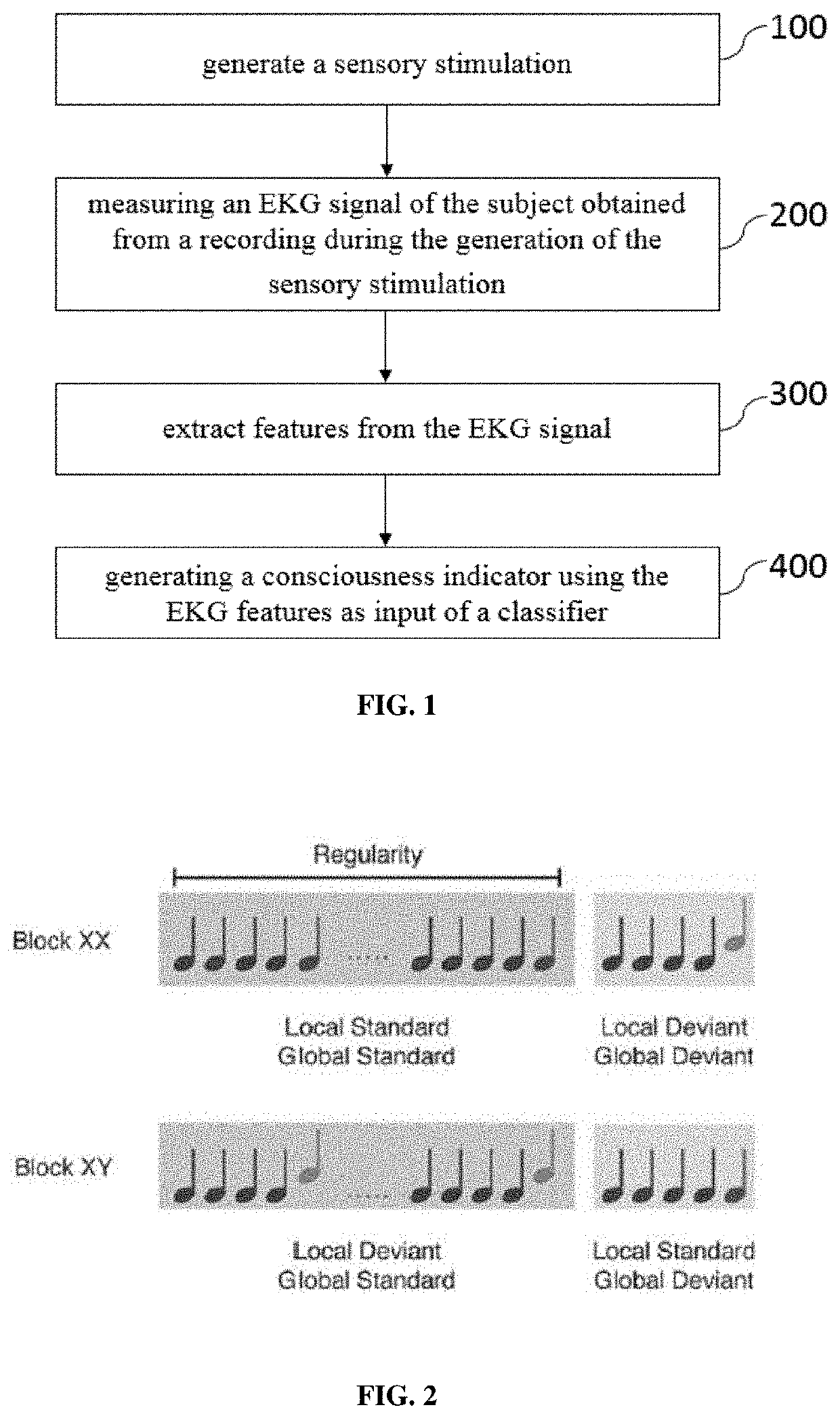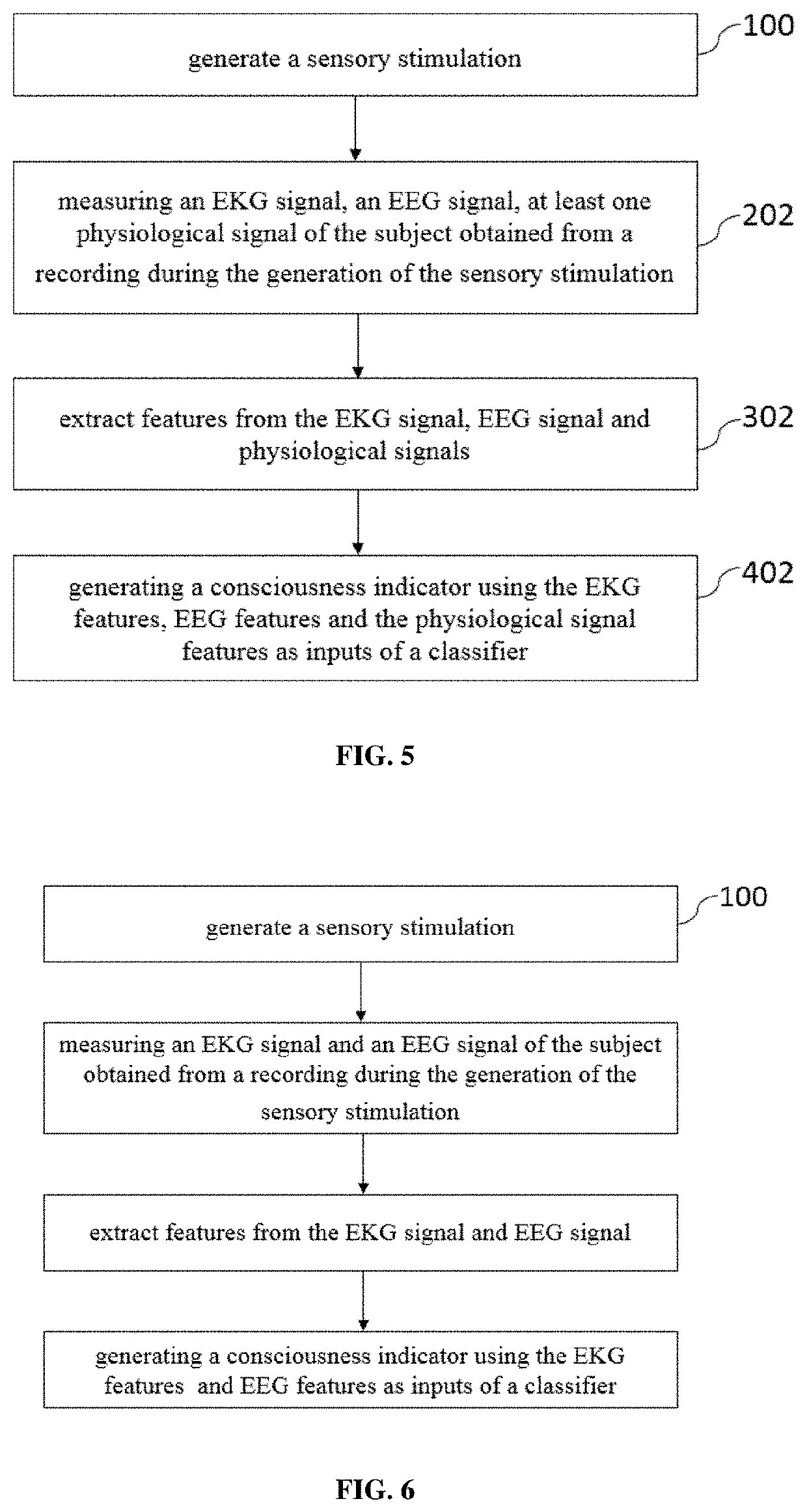System and methods for consciousness evaluation in non-communicating subjects
a non-communicating subject and consciousness technology, applied in the field of physiological signal evaluation, can solve the problems of difficult implementation of neuroimaging, general complexity of neurophysiological techniques, and inability to accurately evaluate non-reflex behavior, and achieve the effect of low computing power and easy disassembly
- Summary
- Abstract
- Description
- Claims
- Application Information
AI Technical Summary
Benefits of technology
Problems solved by technology
Method used
Image
Examples
second embodiment
[0083] represented in FIG. 4, the method of the present invention further comprises a step of receiving at least one additional physiological data of the subject recorded during the sensory stimulation 203. The physiological signal may be chosen among the following: respiratory activity measurements, electrodermal activity measurements, metabolic state measurements, pupillometry measurements.
[0084]According to this second embodiment, the extraction step is configured to further extract at least one physiological feature 303. Said physiological features may be calculated as a modulation of the correlation of the physiological signal and the timing of the sensory stimulation. According to one embodiment, the physiological features are used as further input of the classifier 403.
[0085]From the respiratory activity measurements, multiple features could be calculated as input for the classifier such as the phase shift (i.e. modulation of the correlation of the respiratory activity signal...
third embodiment
[0089] shown in FIG. 5, the method of the present invention comprises a step 202 of measuring an electroencephalographic signal of the subject during the generation of the sensory stimulation.
[0090]In this embodiment, the extraction step further comprises the extraction of at least one EEG feature from the electroencephalographic signal 302 so as to be a further input of the classifier for the generation of the consciousness indicator.
[0091]According the third embodiment, at least one of the following measures are performed on the electroencephalographic signal: permutation entropy, Kolmogorov Complexity, Weighted Symmetrical Mutual Information, Alpha PSD, Normalized Alpha PSD, Beta PSD, Normalized Beta PSD, Delta PSD, Normalized Delta PSD, Theta PSD, Normalized Theta PSD, Median Power Frequency, Spectral Entropy 90, Spectral Entropy 95, Spectral Entropy, Contingent Negative Variation, short-latency sensory potentials, mid-latency sensory potentials, late-latency sensory potentials,...
fourth embodiment
[0103] represented in FIG. 6, the method of the present invention uses only EKG features and EEG features as input of the classifier to deduce the consciousness indicator.
[0104]According to one embodiment, the consciousness indicator is compared to a threshold.
[0105]The present invention further relates to a system 1 for the generation of a consciousness indicator for a non-communicating subject being sensorially stimulated. The main components of the system 1 are an acquisition module 3 and a calculation module 4.
[0106]According to one embodiment, the system 1 comprises an acquisition module 3 configured to perform the acquisition of an electrocardiographic signal during the sensory stimulation of the patient. The system 1 may comprise one or more acquisition devices such as an electrocardiogram, a high density electroencephalogram, a respiratory belt, a microphone, an eye tracking device, a camera, a temperature sensor, a pressure sensor, a CO2 sensor, a volatile organic compound ...
PUM
 Login to View More
Login to View More Abstract
Description
Claims
Application Information
 Login to View More
Login to View More - R&D
- Intellectual Property
- Life Sciences
- Materials
- Tech Scout
- Unparalleled Data Quality
- Higher Quality Content
- 60% Fewer Hallucinations
Browse by: Latest US Patents, China's latest patents, Technical Efficacy Thesaurus, Application Domain, Technology Topic, Popular Technical Reports.
© 2025 PatSnap. All rights reserved.Legal|Privacy policy|Modern Slavery Act Transparency Statement|Sitemap|About US| Contact US: help@patsnap.com



